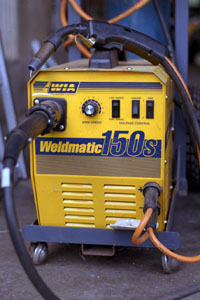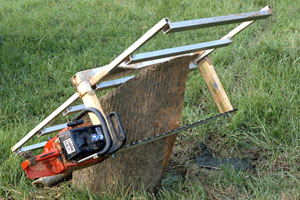Eddie's M.I.G. page
MIG 101
Year
1999
Written
by a Novice for those who know even less.
My ”tips for beginners” page has moved here.
I searched the internet for practical information on MIG
welders and welding and found nothing for the beginner. There were
adds and odd references but little basic information. Even the
user manuals I've seen (or heard about) assume you know the
basics. So here is what I had to learn while buying a MIG and
learning to weld.
The primary reason I wanted a MIG was to
weld 3mm walled aluminum tubes into a rail system for a chainsaw
mill I designed. I can do basic stick welding but I'd
never even seen a MIG up close so it was all new stuff.
Around 25 years ago my brother (RIP) who was a professional
welder told me about the MIG welding he did. He welded petrol
tankers and serious stuff like that. He told me M.I.G. stood for
"Metal - Inert - Gas", this may have been the case then
but modern gas mixtures make this acronym obsolete, I'm told it
now stands for "Metal In Gas" which is not accurate
either because of "gas less" MIG welding. Anyhow the
jist is that stick (arc) welders use a coating around the
stick/electrode which melts,vaporizes or burns to provide a
barrier/shield preventing air reacting with the molten metal. A
MIG uses a gas or gas mixture to displace the air around the arc -
also to preventing air reacting with the molten metal. The
"electrode" is still melted with and electric arc but
the electrode is a special wire which is mechanically fed into
the arc. The feed rate is adjusted depending on the thickness
of metal being welded - the voltage/current is also adjusted.
I
could not really justify owning a MIG all by myself, they are much
more expensive than stick welders and usually the gas bottle is
rented so there is an ongoing expense whether you use it or not. A
friend, Phil agreed to buy one jointly with me. I read specs on
several MIGs via the web and figured I'd want one that could
deliver at least 150 amps - I think I got that about right. I
mentioned our interest in buying a second hand MIG to a farmer who
belongs to my gliding club
and he offered to sell his - a WIA150 - ie 150 amps. He wanted a
bigger one, this welder was fairly new and the price AU$900. We
took a look at it and I did my first MIG weld. It was
pretty much as I expected - it feels a little like squirting
liquid metal onto the job. I welded some mild steel bar and some
sheet steel and got the hang of it fairly quickly. The owner had
set up the MIG and I was spoiled by his electronic welding
mask. Unlike stick welding it's recommended you weld away from
yourself to improve the gas shielding. The other odd thing is -
this welder controls the welding voltage not current and it does
this with 3 switches (ie 8 settings), I would have preferred a
knob or even a rotary switch but I'll get used to it. The other
annoyance was this welder didn't take "mini-spools"
which I'd been told were a standard and I'd already bought a 500
gram mini-spool of aluminum wire. We pondered for a week or two
and then went to buy it. We were hoping to borrow the existing gas
bottle but then we were informed that this gas was for steel and
unsuitable for Aluminum. This made us ponder a few minutes more.
We didn't want multiple gas bottles. We knew about "gas less"
wire so we figure we'd get the gas for Al and use gas less wire
for steel. We re-spooled my Al wire onto a bigger spool, paid our
money and took the MIG to Phil's place. I set up the MIG and
chatted to some passing missionaries while Phil got some gas. The
D-sized bottle of Argon cost AU$55 - that's the price of the gas,
the bottle rental is extra. We had no info regarding voltage
settings or feed rate. I practice for hours on some scrap Al and
mostly made a mess and broke lots of wire. Eventually Phil asks
his neighbor (a pro welder) to take a look. He declared we owned a
nice little MIG and the problem was we had the wrong tip size for
the wire - DOH! The previous owner use one tip for everything but
steel must be easier to weld. We had .8mm wire and a 1.2mm tip.
Later Phil read the manual more carefully and we also had the
wrong sized drive roller. The following week Phil got a range of
tips @ $2.50 each but could not get a new drive roller. The local
agent told Phil our welder could not do Al - this is a load of
rot. They latter changed the story to say the didn't recommend it
for Al because the max current was to low - for 3 mm thickness
this is not the case.
 I
returned to Phil's the following weekend and produced acceptable
welds within a short time, not pretty but they are strong and did
the job. This was joining 25mm square tubing to 50*25 tubing -
both 3mm wall thickness. The feed rate was set to the maximum
setting of 10 - this could be 10 meters/minute but I'm not sure.
The voltage was about 3/4 full voltage. We still had the .9mm feed
roller installed driving .8mm wire..
I
returned to Phil's the following weekend and produced acceptable
welds within a short time, not pretty but they are strong and did
the job. This was joining 25mm square tubing to 50*25 tubing -
both 3mm wall thickness. The feed rate was set to the maximum
setting of 10 - this could be 10 meters/minute but I'm not sure.
The voltage was about 3/4 full voltage. We still had the .9mm feed
roller installed driving .8mm wire..
My next batch of welding didn't go well though. This is almost certainly because the respooled wire had subtle bends in it which didn't pass through the tip smoothly and caused more wire breaks and jam ups. Using an over-sized tip reduced this problem but this also reduces the quality of the weld.
About gas.
Ideally different gas mixtures are used to
weld different metals. Mild steel uses argon mixed with %25
carbon-dioxide (CO2), aluminum uses pure argon, stainless uses
argon with one or two percent oxygen (O2). However we learned that
even some pro welding shops use argon for everything. The CO2
keeps the carbon content in steel weld up and the O2 keeps the
stainless steel soot free. We can live with low carbon steel and
dirty stainless steel (stained steel). For our hobby/business
welding we'll use argon only.
About welding wire.
The wire spool lives inside the
body of the MIG unit and is driven through the centre
of the "cable" connected to the "gun" part of
the MIG. This cable also feeds welding current to the tip,
supplies gas and contains signal wires to the switch on the
"trigger". The drive motor is variable in speed so the
wire feed rate is adjustable. Unlike stick welding where you
choose the thickness of the stick/electrode according to the
thickness of metal being welded - with a MIG you change the feed
rate instead. Because the wire is thin it's possible to weld thin
metal, the wire is also unlikely to stick when cold like
stick/electrodes do. If you loose the arc the wire will melt
rather than stick. Our MIG can take wire from 0.6mm to 1.2mm.
Our steel wire has a thin copper coating to prevent corrosion. You
can weld steel without using gas if you use a gas-less wire.
This wire contains a core of chemicals which provide the same
function as the chemicals around a stick/electrode. Presumably you
end up with slag covering the weld when using the gas less wire.
The wire is more expensive but this is compensated by not needing
to pay for gas.
About welding direction.
Both the manual and advice
from experienced welders says you should be welding away from
yourself when using gas shielded wire ie pushing the gun not
pulling it. I guess this is so you're moving into the gas envelope
as you go. However when you do this you're often stricking the arc
on top of the molten metal bead and the motion is somewhat
un-natural. It's a bit like using a caulking gun - running the
bead away would make a mess. If you run the weld the other way you
can easily keep the arc at the joint where you want it and it's
basically much easier. You're also not passing near the hot
welding as you go. So the last weld I did I broke the rules and
went the other way - the result was the best looking MIG weld
I've ever done. I don't have lab to test the weld but it's much
neater looking and has the best penetration I've seen so far –
YMMV.
Cheers Eddie.M